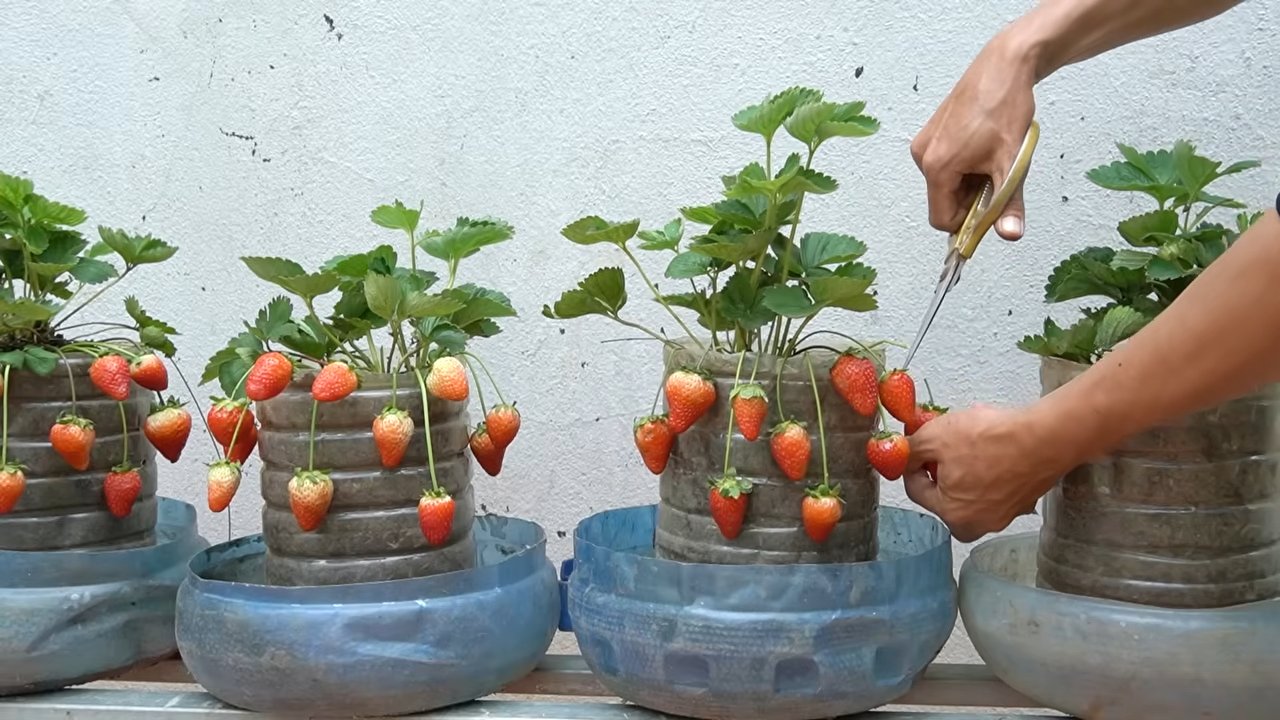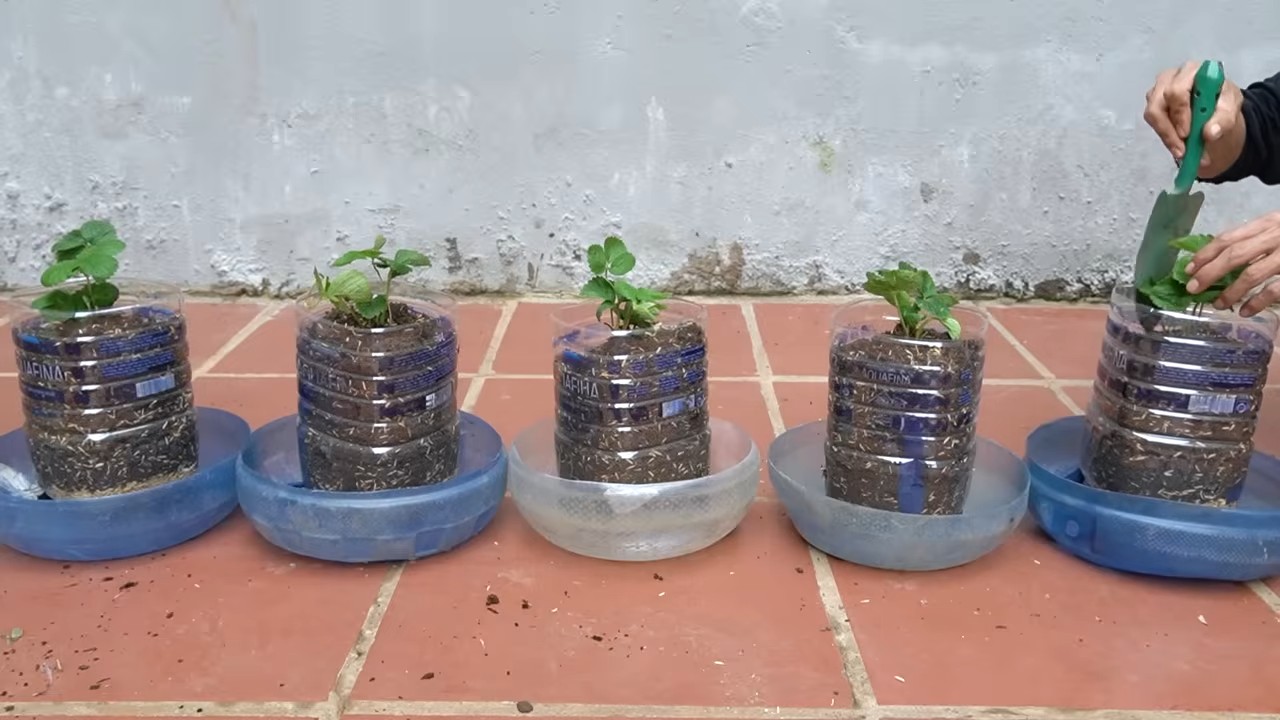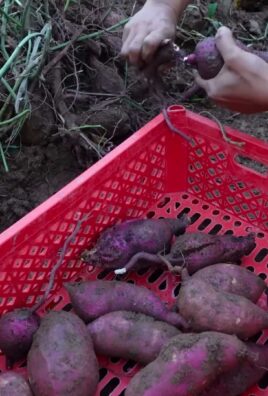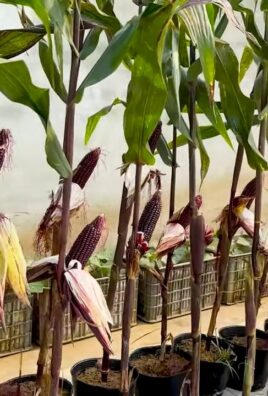Growing Strawberries in a Small Space can feel like a distant dream, especially if you’re limited to a balcony, patio, or even just a sunny windowsill. But guess what? It’s totally achievable, and I’m here to show you how! Forget those sprawling strawberry fields you see in movies; we’re going micro, maximizing every inch for a bountiful harvest of sweet, juicy berries.
For centuries, strawberries have been cherished not only for their delicious flavor but also for their vibrant color and symbolic association with love and abundance. From ancient Roman gardens to medieval monastery plots, these little red gems have held a special place in our hearts and diets. But traditionally, growing them required significant space – a luxury many of us simply don’t have.
That’s where these DIY tricks and hacks come in! Imagine plucking fresh, sun-ripened strawberries right from your own home, adding them to your morning yogurt, or enjoying them as a guilt-free snack. No more trips to the grocery store for bland, overpriced berries! This article is packed with clever solutions for growing strawberries in a small space, from vertical planters and hanging baskets to repurposed containers and smart watering techniques. I’ll guide you through choosing the right varieties, providing optimal sunlight, and protecting your precious plants from pests. Let’s transform your limited space into a strawberry paradise!

Growing Strawberries in Small Spaces: A DIY Vertical Garden Guide
Hey there, fellow gardening enthusiasts! Dreaming of juicy, homegrown strawberries but short on space? Don’t worry, I’ve got you covered! I’m going to walk you through creating your very own vertical strawberry garden – a fantastic way to maximize your yield, minimize ground space, and add a touch of green beauty to your balcony, patio, or even a sunny indoor spot. Let’s get started!
What You’ll Need
Before we dive in, let’s gather our supplies. This project is relatively inexpensive and uses readily available materials. Here’s your shopping list:
* **PVC Pipe:** A length of PVC pipe (4-6 inches in diameter) will form the main structure of your vertical garden. The length will depend on how tall you want your garden to be. I recommend starting with a 4-foot section for easy handling.
* **End Cap for PVC Pipe:** One end cap to seal the bottom of the PVC pipe.
* **Drill with Hole Saw Attachment:** You’ll need a hole saw attachment that’s large enough to create planting holes (2-3 inches in diameter is ideal).
* **Smaller Drill Bit:** For drilling drainage holes.
* **Landscape Fabric or Burlap:** To line the inside of the PVC pipe and prevent soil from washing out.
* **Staple Gun:** To secure the landscape fabric or burlap.
* **Potting Soil:** Choose a high-quality potting mix that’s well-draining. Strawberries love slightly acidic soil.
* **Strawberry Plants:** Select everbearing or day-neutral strawberry varieties for continuous fruiting throughout the season. Bare-root or potted plants will work.
* **Gravel or Small Rocks:** For drainage at the bottom of the pipe.
* **Measuring Tape or Ruler:** For accurate hole placement.
* **Marker or Pen:** To mark the drilling locations.
* **Gloves:** To protect your hands.
* **Safety Glasses:** Essential for drilling.
* **Optional: PVC Primer and Cement:** If you want a more permanent seal for the end cap.
Preparing the PVC Pipe
This is where we transform a simple pipe into a strawberry haven! Take your time and be precise with your measurements and drilling.
1. **Measure and Mark the Planting Holes:** Decide how many rows of strawberries you want and how far apart you want them. I usually space my holes about 6-8 inches apart vertically and stagger them horizontally for better light exposure. Use your measuring tape and marker to mark the center of each hole on the PVC pipe. Remember to leave a few inches of space at the top and bottom of the pipe.
2. **Drill the Planting Holes:** Put on your safety glasses! Using the hole saw attachment on your drill, carefully drill out each of the marked holes. Apply steady pressure and let the drill do the work. Avoid forcing it, as this can crack the PVC.
3. **Drill Drainage Holes:** Flip the pipe over and drill several small drainage holes (using the smaller drill bit) at the bottom of the pipe. This will prevent waterlogging and keep your strawberry roots healthy.
4. **Prepare the End Cap:** If you want a permanent seal, apply PVC primer and cement to the inside of the end cap and the bottom of the PVC pipe. Follow the instructions on the primer and cement containers. Let it dry completely before proceeding. If you prefer a removable end cap for easier cleaning, you can skip this step and simply press the end cap firmly onto the bottom of the pipe.
Lining the PVC Pipe
This step is crucial for preventing soil erosion and keeping your vertical garden tidy.
1. **Measure and Cut the Landscape Fabric:** Measure the inside length of the PVC pipe. Cut a piece of landscape fabric or burlap that’s slightly longer than the pipe. You’ll also need enough width to wrap around the inside circumference of the pipe with some overlap.
2. **Insert and Secure the Fabric:** Carefully insert the landscape fabric into the PVC pipe. Overlap the edges of the fabric and use the staple gun to secure it to the inside of the pipe. Make sure the fabric is snug against the pipe walls. Trim any excess fabric at the top.
Planting Your Strawberries
Now for the fun part – bringing your strawberry garden to life!
1. **Add Drainage Material:** Pour a layer of gravel or small rocks into the bottom of the PVC pipe. This will improve drainage and prevent the soil from becoming waterlogged. A layer of about 4-6 inches is ideal.
2. **Fill with Potting Soil:** Slowly add potting soil to the PVC pipe, filling it up to just below the first row of planting holes. Gently tap the pipe to settle the soil and remove any air pockets.
3. **Plant the First Row of Strawberries:** Carefully remove a strawberry plant from its container. Gently loosen the roots and place the plant into one of the planting holes. Add more potting soil around the roots to secure the plant. Repeat this process for all the planting holes in the first row.
4. **Continue Filling and Planting:** Add more potting soil to the pipe, filling it up to the next row of planting holes. Plant the strawberries in the second row, and so on, until you’ve planted all the holes.
5. **Top Off with Soil:** Fill the remaining space at the top of the pipe with potting soil.
Caring for Your Vertical Strawberry Garden
Congratulations! You’ve created your own vertical strawberry garden. Now, let’s make sure your plants thrive.
* **Watering:** Water your strawberry plants regularly, especially during hot, dry weather. Check the soil moisture by sticking your finger into the soil. If it feels dry to the touch, it’s time to water. Water slowly and deeply, allowing the water to drain out of the drainage holes. Avoid overwatering, as this can lead to root rot.
* **Sunlight:** Strawberries need at least 6-8 hours of sunlight per day to produce a good crop of fruit. Place your vertical garden in a sunny location. If you’re growing indoors, you may need to supplement with grow lights.
* **Fertilizing:** Feed your strawberry plants with a balanced fertilizer every 2-3 weeks during the growing season. Follow the instructions on the fertilizer package.
* **Pruning:** Remove any dead or yellowing leaves to keep your plants healthy and prevent disease.
* **Pest Control:** Keep an eye out for pests such as aphids, slugs, and snails. Handpick them off the plants or use an organic pest control spray.
* **Winter Care:** In colder climates, protect your strawberry plants from frost by covering them with a blanket or moving them to a sheltered location.
Troubleshooting
Even with the best care, you might encounter a few challenges. Here are some common issues and how to address them:
* **Yellowing Leaves:** This could be a sign of overwatering, underwatering, or nutrient deficiency. Check the soil moisture and adjust your watering schedule accordingly. Fertilize your plants with a balanced fertilizer.
* **Lack of Fruit:** This could be due to insufficient sunlight, poor pollination, or nutrient deficiency. Make sure your plants are getting enough sunlight. You can hand-pollinate the flowers by gently brushing them with a small paintbrush. Fertilize your plants with a fertilizer that’s high in phosphorus.
* **Root Rot:** This is caused by overwatering. Make sure your soil is well-draining and avoid overwatering. If you suspect root rot, remove the affected plants and replant them in fresh soil.
* **Pests:** Regularly inspect your plants for pests and take action as soon as you notice them.
Alternative Materials and Ideas
Want to get creative? Here are some alternative materials and ideas for your vertical strawberry garden:
* **Gutter Garden:** Use sections of rain gutter instead of PVC pipe. This is a great way to recycle old gutters.
* **Pallet Garden:** Repurpose a wooden pallet into a vertical strawberry garden.
* **Hanging Baskets:** Plant strawberries in hanging baskets and hang them from your balcony or patio.
* **Stacked Planters:** Use stacked planters to create a tiered strawberry garden.
* **Fabric Grow Bags:** Use fabric grow bags and hang them from a wall or fence.
Enjoying Your Harvest
The best part of growing your own strawberries is, of course, enjoying the delicious fruit! Harvest your strawberries when they are fully ripe and red. Gently twist them off the plant, being careful not to damage the fruit. Eat them fresh, use them in desserts, or make jam.
Growing strawberries in a small space is totally achievable with a vertical garden. It’s a rewarding project that brings fresh, homegrown goodness right to your doorstep. Happy gardening!

Conclusion
So, there you have it! Transforming your limited space into a thriving strawberry patch is not only achievable but also incredibly rewarding. This DIY approach to growing strawberries in small spaces offers a multitude of benefits, from fresh, delicious berries right at your fingertips to the sheer joy of nurturing life and adding a touch of green to your urban environment. Forget those bland, store-bought strawberries that lack the vibrant flavor of homegrown produce. With a little ingenuity and effort, you can cultivate a bountiful harvest of sweet, juicy strawberries that will tantalize your taste buds and impress your friends and family.
But the advantages extend beyond just the taste. This method is incredibly space-efficient, making it perfect for balconies, patios, or even sunny windowsills. It’s also a fantastic way to reduce your carbon footprint by minimizing your reliance on commercially grown and transported produce. Plus, you have complete control over the growing process, ensuring that your strawberries are free from harmful pesticides and chemicals.
Don’t be afraid to experiment and personalize your strawberry-growing setup. Consider using different types of containers, such as hanging baskets, stacked planters, or even repurposed materials like old tires or pallets. You can also try different varieties of strawberries to find your favorites. Everbearing varieties will provide a continuous harvest throughout the growing season, while June-bearing varieties offer a larger crop all at once.
For an added touch of visual appeal, interplant your strawberries with companion plants like basil, thyme, or marigolds. These herbs and flowers not only enhance the beauty of your garden but also help to deter pests and attract beneficial insects. You can also add a layer of mulch around your strawberry plants to help retain moisture, suppress weeds, and keep the berries clean.
We understand that embarking on a new gardening project can sometimes feel daunting, but trust us, this DIY trick is surprisingly simple and straightforward. With a little planning and preparation, you’ll be well on your way to enjoying a delicious harvest of homegrown strawberries.
We wholeheartedly encourage you to give this method a try. Imagine the satisfaction of picking your own ripe strawberries and using them in your favorite recipes, from strawberry shortcake to smoothies to homemade jam. The possibilities are endless!
And most importantly, we want to hear about your experiences! Share your photos, tips, and challenges in the comments section below. Let’s create a community of strawberry enthusiasts who are passionate about growing their own food and sharing their knowledge with others. Together, we can transform even the smallest spaces into thriving strawberry paradises. So, grab your gardening gloves, gather your supplies, and get ready to embark on a delicious and rewarding adventure. Happy growing!
Frequently Asked Questions (FAQ)
What is the best type of strawberry to grow in a small space?
The best type of strawberry for small spaces depends on your preferences and growing conditions. However, everbearing varieties are generally recommended because they produce fruit throughout the growing season, providing a more consistent harvest. Some popular everbearing varieties include Albion, Seascape, and Ozark Beauty. Day-neutral varieties are also a good choice, as they are less sensitive to day length and can produce fruit even in shady conditions. June-bearing varieties, while producing a larger crop all at once, might not be as ideal for small spaces if you’re looking for a continuous supply of strawberries. Consider your local climate and the amount of sunlight your space receives when making your selection. Researching specific varieties and their suitability for your region is always a good idea.
How much sunlight do strawberries need?
Strawberries thrive in full sun, which means they need at least 6-8 hours of direct sunlight per day. Without enough sunlight, your strawberry plants may produce fewer berries, and the berries may be smaller and less flavorful. If you’re growing strawberries indoors or in a shady location, you may need to supplement with artificial lighting, such as grow lights. Position the grow lights close to the plants and provide them with 12-16 hours of light per day. Monitor your plants closely and adjust the lighting as needed to ensure they are getting enough light.
What kind of soil is best for growing strawberries?
Strawberries prefer well-draining, slightly acidic soil with a pH of 5.5 to 6.5. You can use a commercial potting mix specifically formulated for fruits and vegetables, or you can create your own mix by combining equal parts of garden soil, compost, and perlite or vermiculite. The compost will provide essential nutrients, while the perlite or vermiculite will improve drainage. Avoid using heavy clay soil, as it can retain too much moisture and lead to root rot. Before planting, amend the soil with organic matter, such as compost or aged manure, to improve its fertility and drainage.
How often should I water my strawberry plants?
Water your strawberry plants regularly, especially during hot, dry weather. The soil should be kept consistently moist but not waterlogged. Water deeply and thoroughly, allowing the water to soak into the soil. Avoid watering the foliage, as this can promote fungal diseases. Check the soil moisture regularly by sticking your finger into the soil. If the top inch of soil feels dry, it’s time to water. During periods of heavy rain, you may need to reduce watering to prevent overwatering.
How do I fertilize my strawberry plants?
Fertilize your strawberry plants regularly to ensure they have the nutrients they need to produce a bountiful harvest. Use a balanced fertilizer specifically formulated for fruits and vegetables, such as a 10-10-10 or 12-12-12 fertilizer. Follow the instructions on the fertilizer package for application rates. Fertilize your plants in the spring, before they start to bloom, and then again after the first harvest. Avoid over-fertilizing, as this can lead to excessive foliage growth and fewer berries. You can also supplement with organic fertilizers, such as compost tea or fish emulsion.
How do I protect my strawberries from pests and diseases?
Strawberries are susceptible to a variety of pests and diseases, including aphids, spider mites, slugs, snails, and fungal diseases like powdery mildew and gray mold. To protect your plants, inspect them regularly for signs of pests or diseases. Remove any infected leaves or berries immediately. You can also use organic pest control methods, such as insecticidal soap, neem oil, or diatomaceous earth. To prevent fungal diseases, ensure good air circulation around your plants and avoid overwatering. Mulching around the plants can also help to prevent soil-borne diseases. Consider using row covers to protect your plants from pests and birds.
How do I overwinter my strawberry plants?
In colder climates, strawberry plants need to be protected during the winter months. After the first frost, cut back the foliage to about 2 inches above the crown. Mulch the plants heavily with straw or leaves to insulate them from the cold. In very cold climates, you may need to move the plants indoors to a cool, dark location, such as a garage or basement. Water the plants sparingly during the winter months, just enough to keep the soil from drying out completely. In the spring, remove the mulch gradually as the weather warms up.
Can I grow strawberries indoors?
Yes, you can grow strawberries indoors, but you’ll need to provide them with adequate light and warmth. Place your strawberry plants in a sunny window that receives at least 6-8 hours of direct sunlight per day. If you don’t have enough natural light, you can supplement with grow lights. Keep the temperature between 60-75°F (15-24°C). Water your plants regularly and fertilize them as needed. You may also need to hand-pollinate the flowers to ensure fruit production.
How long does it take for strawberries to produce fruit?
The time it takes for strawberries to produce fruit depends on the variety and growing conditions. Generally, everbearing varieties will start producing fruit within a few months of planting, while June-bearing varieties will produce fruit the following spring. Be patient and provide your plants with the care they need, and you’ll be rewarded with a delicious harvest of homegrown strawberries.
What are some creative ways to grow strawberries in small spaces?
Beyond traditional containers, consider vertical gardening options like stacked planters, hanging baskets, or even repurposed pallets. These methods maximize space and add visual interest. You can also create a strawberry tower using PVC pipes or plastic bottles. Get creative and find a solution that fits your space and style. Remember to ensure proper drainage and sunlight exposure for optimal growth.




Leave a Comment